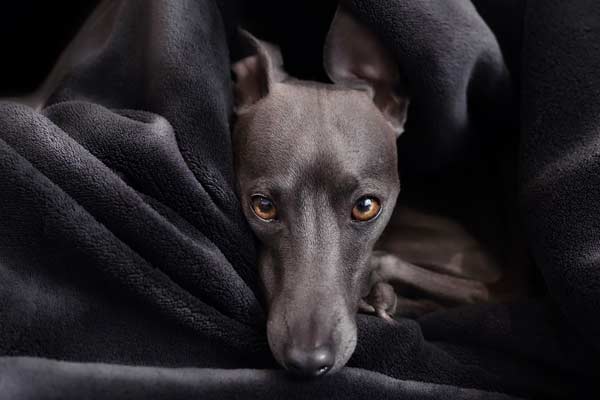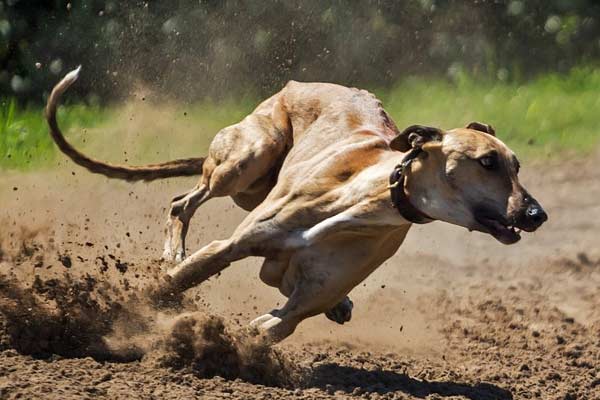Can Greyhounds Really Be Left Alone? The Surprising Answer
Greyhounds are majestic and beautiful creatures, but they’re also incredibly sensitive. The sighthound breed is prone to anxiety, mainly when left alone for too long.
If you’ve ever asked yourself, “how long can a greyhound be left alone?” this blog post is for you!
We’ll explore the temperament of the Greyhound breed, discuss how to recognize signs of separation anxiety in your pup, and offer tips on keeping them entertained while you’re away.
So let’s dive right in and learn all about these beautiful puppies!
Greyhound Temperament
Greyhounds are loving, loyal companions who thrive on human interaction and attention. Greyhounds typically have an even temperament and make excellent family pets as they tend to be gentle with children.
Can Greyhounds Be Left Alone?
Yes, greyhounds can be left alone for 6-8 hours at a time, but not more than that. Beyond this timeframe, they may become bored and lonely, so it is essential to provide mental stimulation while you are away.
Separation anxiety can occur in some cases, so recognizing the signs and knowing how to deal with it is key to providing the best possible care for your pet.
Tips for Keeping Your Greyhound Entertained While You’re Away
Tips for Keeping Your Greyhound Entertained While You’re Away
1. Provide your pet with lots of toys and puzzle-like objects to keep them active and engaged while you’re away. These can include interactive toys such as treat dispensers, puzzle feeders, fetching games, and chew toys.
2. Provide plenty of physical and mental stimulation for your pup by engaging in regular exercise or training sessions.
3. Give your pup a window with a view, as this can provide much-needed distraction and mental stimulation when alone.
4. Distract your pup with television and music, as this can help keep them calm and relaxed while you’re away. Just make sure that the volume isn’t too loud.
5. Utilize food dispensing toys to keep your pup entertained and engaged for hours.
6. Start the day with a high activity level to tire out your pup and ensure they’re ready for a nap while you’re away.
Do Greyhounds Have Separation Anxiety?
Yes, greyhounds can suffer from separation anxiety when they are left alone for too long. It is essential to provide them with enough mental stimulation, and a secure space where your pup feels safe can help ease their anxiety.
How to Recognize Greyhound Separation Anxiety
Separation anxiety signs in greyhounds can include excessive barking, whining, pacing, drooling, hypervigilance, trembling, or constantly following their person around the house.
These behaviors typically result from the greyhound feeling stressed when they can’t see their owner and being unable to determine when they will return.
Some greyhounds may become destructive and claw at furniture or chew on objects due to boredom and loneliness if left alone for too long.
You should be aware of these signs so that you can take steps toward helping your pup be comfortable temporarily being apart from you.
Notice any anxious behavior in your pet before leaving the house, such as panting heavily or trembling, which indicates they are not happy with being left alone. So, it is essential to act quickly to prevent unwanted destruction!
Why Is Anxiety Common in Greyhounds?
Anxiety is common in greyhounds because of their sensitive nature and a lack of early socialization in the domestic environment, which makes them uncertain about unfamiliar surroundings and causes fear, leading to problematic behaviors.
Genetics may also contribute by creating a predisposition for anxiety-related behaviors.
A combination of environmental factors and genetics can make it more likely for an anxious greyhound to develop emotional issues such as separation anxiety or other behavioral problems when faced with new situations.

How to Deal with Greyhound Separation Anxiety?
1. Go for a walk with your dog before leaving the house.
2. Avoid touching, talking to, or making eye contact with your dog when you’re about to leave to prevent any farewell cues that may trigger their anxiety.
3. Gently say goodbye long before it’s time for you to head out the door so they don’t realize you’re leaving immediately and can gradually adjust their emotions accordingly.
4. Remain calm yet assertive throughout the process, as demonstrating distress or hesitation may fuel their anxious feelings and create an undesirable habit of relying on human comfort instead of self-comforting tools when left alone.
5. Start slowly by gradually increasing your time away from them while always providing rewards upon return until they are comfortable being apart from you for extended periods.
6 . Leave some audiobook playing to keep them calm and relaxed while you’re away; make sure that the volume isn’t too loud so that it doesn’t disturb your neighbors or other pets.
7 . Utilize food dispensing toys to keep your pup entertained and occupied while you’re away.
What Helps an Anxious Greyhound?
Here are some tips on how to reduce dog anxiety and help an anxious greyhound:
1. Seek a positive reinforcement dog trainer to help them learn new behavior patterns and coping mechanisms when faced with stressful situations.
2. Make the greyhound visible so you can monitor their behavior, if possible, using gates, a leash, or small fences in the house.
3. Consider using a muzzle for additional safety and managing anxious behaviors.
4. Try changing your regular vet, if possible, to one who has more experience with animals exhibiting signs of anxiety or fearfulness, as they may be better able to suggest remedies or treatments that other vets would not be aware of.
5. Learn your greyhound’s body language as it can tell you when they’re feeling uncomfortable in certain situations; take note of signs such as ears pulled back, lifting their tail tightly against the body, and tense facial expressions, so you know what triggers their stress responses before they become too severe for comfort and intervention is needed right away!
6 Consider looking into medication options, especially if behavioral therapies alone don’t seem enough to help your pup manage stressful episodes effectively over time – consulting a professional vet about this is essential!
7. Find a shared interest or activity your pup enjoys and engage with them to help keep their minds occupied and distracted from any negative emotions they may be experiencing.
8. Know your limits when it comes to providing comfort for an anxious greyhound, as too much of it can increase their reliance on human contact and cause further issues down the line; instead, try to reward good behavior when they display it and work on teaching them new coping mechanisms.
How Do You Calm an Anxious Dog?
1. Provide your dog with plenty of exercises and physical activity to tire them out physically and mentally.
2. Give them a safe, comfortable place to rest – like their bed or crate – and make sure the space is away from potential triggers that could increase their anxiety levels.
3. Massage, snuggles, and brushing can help relax an anxious dog by providing a distraction from troubling thoughts or fears they may have while also stimulating dopamine production (the calming hormone).
4. Create mental stimulation with toys, puzzles, and games specifically designed for dogs to keep them occupied when feeling anxious or restless; food dispensing toys are great!
5. Be consistent with positive reinforcement techniques when rewarding good behaviors during stress, as it will help teach the pup new coping mechanisms over time instead of relying on human comfort alone during episodes of distress.
6 Consider speaking to a vet about medication options if behavioral therapies aren’t enough to manage your pup’s stress levels effectively; however, consult with a professional before making any decisions regarding this route, as there may be other underlying factors that need addressed first!
conclusion
Anxious greyhounds need support, understanding, and patience to help them become comfortable in their environment.
By providing your pup with plenty of exercises, a safe place to rest away from triggers, positive reinforcement when they display good behavior, and mental stimulation through toys or games, you can create an atmosphere where your pup feels secure and content.
Utilize food dispensing toys to keep your dog entertained while you’re away.
If behavioral therapies alone aren’t enough to manage stress levels effectively, consider speaking with a vet about medication options before making any decisions.






